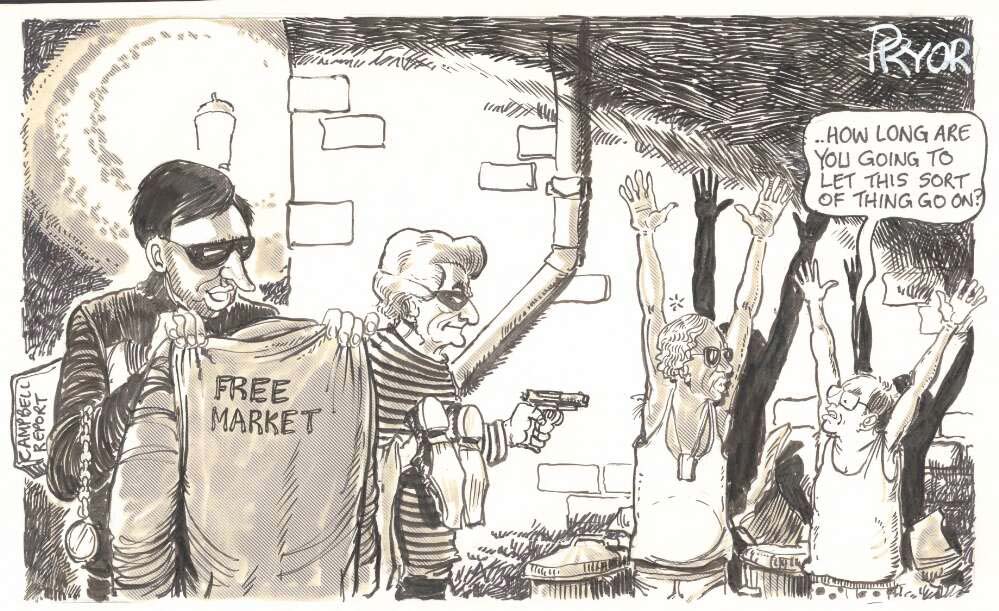Australia’s 24th Prime Minister

20 December 1991 to 11 March 1996
Paul Keating’s initiatives as Prime Minister included establishment of the Republican Advisory Committee, the passage of Indigenous land rights legislation, encouraging the process of reconciliation between Aboriginal and other Australians, and reform of vocational education and training.
Earlier, as Treasurer, he had pursued a radical policy of economic deregulation.
Keating's beginnings
Paul John Keating was born in Sydney, New South Wales, on 18 January 1944.
He was the first of four children of Matt and Min Keating, and grew up in Bankstown, an industrial outer western suburb of Sydney. He attended a Catholic school, De La Salle College, and later studied at Belmore and Sydney Technical Colleges.
Keating left school at 15, the year he joined the Australian Labor Party. He worked in clerical jobs before joining the staff of the Federated Municipal and Shire Council Employees’ Union, the trade union representing workers in local government.
He became the union’s industrial advocate (the officer responsible for arguing its claims before wage tribunals) and in his spare time managed a rock band, the Ramrods.
He married Anna (‘Annita’) van lersel in 1975, and they had four children.
Keating's entry into federal politics
Paul Keating was elected to the House of Representatives for the Sydney seat of Blaxland at a general election on 25 October 1969. He held the seat through the next 10 general elections.
Keating first became a minister in Gough Whitlam’s government, being appointed Minister for Northern Australia only three weeks before the Governor-General removed the government from office on 11 November 1975.
While in opposition from 1975 to 1983 Keating was the Labor spokesman for a series of portfolios: Agriculture from January 1976 to March 1976; Minerals and Energy from March 1976 to November 1980; National Development from December 1977 to November 1980; Northern Australia from March 1980 to November 1980; Resources and Energy from November 1980 to January 1983; and Treasury from January 1983 to March 1983. Keating also served as president of Labor’s New South Wales state branch from 1979 to 1983.
Economic deregulation by Keating
When Bob Hawke led Labor into government at the general election on 5 March 1983, Keating became Treasurer. He held the portfolio for the next eight years and three months.
While Keating was Treasurer, the government licensed the operation of foreign banks in Australia and floated the Australian dollar on international money markets in 1983 as the first step towards deregulating the national economy.
Early in Keating’s period as Treasurer, following his moves to deregulate Australia’s economy, he won the praise of financial journalists and from the business sector. Keating was dubbed the ‘World’s Greatest Treasurer’.
Recession
However, the New York stock market crash of October 1987 soon had ‘ripple’ effects in Australia, ending the speculative boom which had followed the government’s moves to deregulate the economy.
In 1990–1991 the Australian economy slid into recession. The lack of competitiveness of Australian exports on world markets was becoming evident. Crises in rural and manufacturing industries led to job losses, and high unemployment.
Keating’s comment that the recession was having a necessary corrective effect on the economy – ‘This is the recession we had to have’ – was widely criticised.
As well as holding the Treasury portfolio, Keating served as Deputy Prime Minister and Minister Assisting the Prime Minister for Commonwealth–State Relations from April 1990 to June 1991. This meant that he was responsible for dealings between federal and state governments.
He held both positions until challenging Hawke for the Labor leadership on 3 June 1991. Losing the caucus vote on the leadership, Keating resigned his ministries and returned to the back bench.
Prime Minister Paul Keating
Keating became Prime Minister on 20 December 1991, after challenging Hawke for the second time in six months.
Although he was opposed by the ‘Left’ faction, he had sufficient supporters to win the ballot. Even his opponents recognised that his sharp wit, talent for apt epigrams, forceful style of argument and confidence in leading parliamentary debate made him one of Labor’s chief assets.
On 13 March 1993 Keating led Labor to victory in a general election which most political commentators expected it to lose. Keating’s own determined and effective campaigning against the Goods and Services Tax, a tax on general consumption proposed by opposition leader John Hewson, was a key factor in Labor’s victory.
Initiatives implemented by Keating government
- 1992: Establishment of a Council for Aboriginal Reconciliation. Following the High Court’s Mabo decision in June 1992, Keating took a personal lead to secure social justice for Aborigines and Torres Strait Islanders by presenting to parliament two major items of legislation to give Indigenous peoples access to land. These were the Native Title Bill (16 November 1993) and the Land Fund Bill (30 August 1994).
- 1993: Keating appointed a Republic Advisory Committee to report on options available to Australia for becoming a republic. Keating had personally become the nation’s leading advocate for a republican form of government.
- 1992–1994: Government focused on strengthening Australia’s links with its neighbours in the ASEAN (Association of South East Asian Nations) group, and worked to achieve closer regional economic cooperation through the APEC (Asia-Pacific Economic Cooperation) organisation.
- 1994: Working Nation white paper setting out strategies for achieving employment expansion, particularly among the young, and for raising workforce skills.
- 1995: Premiers conference agreed on a program of opening state-owned monopolies in electricity, gas, water and transport to commercial competition, in order to make the provision of utilities more efficient.
After more than four years in office, Keating took the nation to his second election as Prime Minister on 2 March 1996. By this time, mounting foreign debt, high unemployment and high interest rates were causing widespread concern, and Labor’s ability to manage the economy was increasingly in question.
Labor suffered a resounding defeat, with the Liberal–National Party coalition winning convincingly. Keating immediately resigned as Labor leader and quit parliament.
Keating's life beyond politics
After retiring from parliament, Keating devoted himself to developing business interests. He has also acted as an occasional commentator on major events in Australia.
Legislation passed under Keating
During Paul Keating’s prime ministership the following notable legislation was introduced:
- The Antarctic (Environmental Protection) Legislative Amendment Act 1992 gave legislative effect to obligations arising from the Protocol on Environmental Protection to the Antarctic Treaty (the Madrid Protocol).
- The Australian National Training Authority Act 1992 established the Australian National Training Authority and its administration.
- The Disability Discrimination Act 1992 provided for national uniform legislation to make discrimination on the basis of disability unlawful.
- The Endangered Species Protection Act 1992 provided a framework for the protection of endangered species and ecological communities.
- The Broadcasting Services Act 1992 gave legislative effect to the government’s 1987 election commitment to reform the Broadcasting Act 1942 and establish the Australian Broadcasting Authority for the purpose of regulating all aspects of broadcasting.
- The Native Title Act 1993 legislated on matters arising from the High Court of Australia decision in Mabo v Queensland (No. 2) and provided a national system for the recognition and protection of native title and for its co-existence with the national land management system.
- The Land Fund and Indigenous Land Corporation (ATSIC Amendment) Bill 1995 amended the Aboriginal and Torres Strait Islander Commission Act 1989 to establish the Aboriginal and Torres Strait Islander Land Fund and Indigenous Land Corporation.
In our collection
